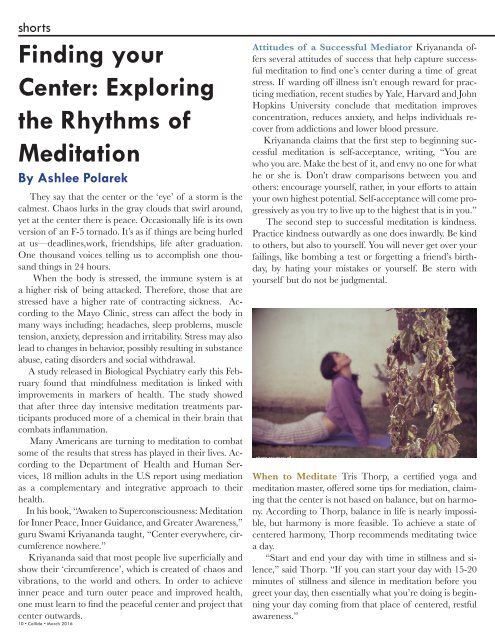Collide Issue 30: The Middle
Create successful ePaper yourself
Turn your PDF publications into a flip-book with our unique Google optimized e-Paper software.
shorts<br />
Finding your<br />
Center: Exploring<br />
the Rhythms of<br />
Meditation<br />
By Ashlee Polarek<br />
<strong>The</strong>y say that the center or the ‘eye’ of a storm is the<br />
calmest. Chaos lurks in the gray clouds that swirl around,<br />
yet at the center there is peace. Occasionally life is its own<br />
version of an F-5 tornado. It’s as if things are being hurled<br />
at us—deadlines,work, friendships, life after graduation.<br />
One thousand voices telling us to accomplish one thousand<br />
things in 24 hours.<br />
When the body is stressed, the immune system is at<br />
a higher risk of being attacked. <strong>The</strong>refore, those that are<br />
stressed have a higher rate of contracting sickness. According<br />
to the Mayo Clinic, stress can affect the body in<br />
many ways including; headaches, sleep problems, muscle<br />
tension, anxiety, depression and irritability. Stress may also<br />
lead to changes in behavior, possibly resulting in substance<br />
abuse, eating disorders and social withdrawal.<br />
A study released in Biological Psychiatry early this February<br />
found that mindfulness meditation is linked with<br />
improvements in markers of health. <strong>The</strong> study showed<br />
that after three day intensive meditation treatments participants<br />
produced more of a chemical in their brain that<br />
combats inflammation.<br />
Many Americans are turning to meditation to combat<br />
some of the results that stress has played in their lives. According<br />
to the Department of Health and Human Services,<br />
18 million adults in the U.S report using mediation<br />
as a complementary and integrative approach to their<br />
health.<br />
In his book, “Awaken to Superconsciousness: Meditation<br />
for Inner Peace, Inner Guidance, and Greater Awareness,”<br />
guru Swami Kriyananda taught, “Center everywhere, circumference<br />
nowhere.”<br />
Kriyananda said that most people live superficially and<br />
show their ‘circumference’, which is created of chaos and<br />
vibrations, to the world and others. In order to achieve<br />
inner peace and turn outer peace and improved health,<br />
one must learn to find the peaceful center and project that<br />
center outwards.<br />
10 • <strong>Collide</strong> • March 2016<br />
Attitudes of a Successful Mediator Kriyananda offers<br />
several attitudes of success that help capture successful<br />
meditation to find one’s center during a time of great<br />
stress. If warding off illness isn’t enough reward for practicing<br />
mediation, recent studies by Yale, Harvard and John<br />
Hopkins University conclude that meditation improves<br />
concentration, reduces anxiety, and helps individuals recover<br />
from addictions and lower blood pressure.<br />
Kriyananda claims that the first step to beginning successful<br />
meditation is self-acceptance, writing, “You are<br />
who you are. Make the best of it, and envy no one for what<br />
he or she is. Don’t draw comparisons between you and<br />
others: encourage yourself, rather, in your efforts to attain<br />
your own highest potential. Self-acceptance will come progressively<br />
as you try to live up to the highest that is in you.”<br />
<strong>The</strong> second step to successful meditation is kindness.<br />
Practice kindness outwardly as one does inwardly. Be kind<br />
to others, but also to yourself. You will never get over your<br />
failings, like bombing a test or forgetting a friend’s birthday,<br />
by hating your mistakes or yourself. Be stern with<br />
yourself but do not be judgmental.<br />
photo courtsey of<br />
creativecommmons<br />
When to Meditate Tris Thorp, a certified yoga and<br />
meditation master, offered some tips for mediation, claiming<br />
that the center is not based on balance, but on harmony.<br />
According to Thorp, balance in life is nearly impossible,<br />
but harmony is more feasible. To achieve a state of<br />
centered harmony, Thorp recommends meditating twice<br />
a day.<br />
“Start and end your day with time in stillness and silence,”<br />
said Thorp. “If you can start your day with 15-20<br />
minutes of stillness and silence in meditation before you<br />
greet your day, then essentially what you’re doing is beginning<br />
your day coming from that place of centered, restful<br />
awareness.”


